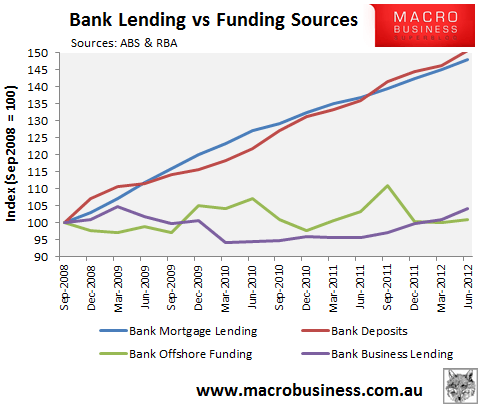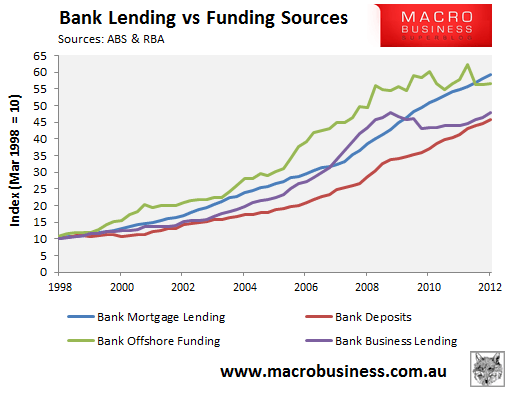
Whilst my colleague Michael Feller was yesterday concerned with our cosmic wellbeing in a philosophical treatise on the usefulness of GDP as a measure of economic health, I am focussed on a problem much closer to home.
Whether we’d like to live in a Panglossian country of verdant forests dotted with proud antelope grazing rich soils shared with our own fecund production, fine cuisine, wine, and conversation that we harvest wrapped in togas and self-satisfaction is beside the point. We just can’t now or in any reasonable assessment of the future because we’ve already stuffed ourselves so full of debt that we need to work it off.
And I’m wondering how the bloody hell we’re going to do it.
The buzz from our economic elite – the RBA, Treasury and their media mouthpieces – is that now, as the peak in the mining boom passes, we’re going to go easily and swiftly back to the future of debt-fueled, housing-led growth. The RBA’s Deputy Cap’t, Phil Lowe, made this crystal clear in a speech yesterday:
This weakness in the construction sector, particularly of new homes, has been one of the bigger surprises in the economic outcomes over recent times. Looking forward, a pick-up in construction activity is one of the factors that could provide an offset to the eventual moderation in the current very high level of investment in the resources sector.
This is a sorely contestable point which, as usual, is simply being accepted as a fait accompli by our economic elites. Quite aside from the question of whether or not this is a wise course for the economy, there is a question of whether this back to the future approach to economic growth is possible. In order to grow, housing markets need credit growth and there are big unanswered questions about how much of that Australian banks can actually deliver.
Consider. NAB’s finance director Mark Joiner recently declared that we are at “peak debt” in terms of our offshore borrowings:
“I regard us as at a peak in wholesale borrowing, not even in percentage terms but in dollar terms. Australian banks will only be able to grow in line with what they are able to bring in on the customer side (with deposits). So they will not be able to go with an upswing in credit. In my view, the Australian banks, for a long time, will only be able to buy the asset side of their balance sheet dollar for dollar with what they bring in on the customer side”.
In short, the banks will only be able to lend one dollar for every dollar of local deposit growth. Now, in terms of financial stability, that may sound quite sensible, and indeed it is. But in terms of the plan to stimulate growth in housing credit, it’s a different story.
According to APRA, Australian deposit-taking institutions have $1.54 trillion in deposits covering assets of 2.71 trillion. Deposits are growing at 12% per annum so that’s a total of available credit growth right now of $185 billion or 6.8% per annum. Given aggregate credit growth is currently running at 4.1%, that’s some surplus credit capacity. As such, the banks have been able to match credit growth with deposits since the GFC:

However, that is not the end of the story. Deposit growth is itself a function of many different things: attitudes in the community and business, the amount of lending already underway (which creates deposits), the balance of growth forces at work across the private, public and external sectors, the level of the currency as well as interest rates and, crucially, the degree of income growth in the economy.
For instance, between 1997 and 2007, a combination of raging credit growth and a terms of trade boom helped deposits grow at an average of 10.2% per annum:

And as you can see, since the GFC it has been even better. Since 2008, the factors that determine deposit growth have been in perfect alignment: conservative spending and high interest rates have accumulated savings, credit growth has declined but remained positive, governments have borrowed offshore and spent the money at home, the rising currency has attracted a potent carry trade of international deposits to local banks and the terms of trade boom has delivered very high income growth. Thus it is no surprise to find that from early 2008 up until today average annual deposit growth accelerated to 13.2%.
But now, as we aim to boost housing construction, all of these tail-winds for deposits are quickly reversing. Interest rates are falling, the dollar is falling, the terms of trade are falling, income growth is falling, government spending is falling and credit growth remains subdued.
So, let’s assume (not unreasonably) that deposit growth will also diminish, to around 8% per annum in the next year. In that event, total credit growth capacity would drop to 4.55%. That does not leave much room to expand above the current rate of growth. Bugger all in fact.
So, what is to be done?
Well, if the RBA succeeds in its declared intention to accelerate credit growth for more house building there are five options. The first is that banks begin to grow their offshore borrowings again. However, both ratings agencies and regulators (including the RBA) have warned that to do so will risk bank stability and credit ratings.
The second option is that the banks lend less to business and more for mortgages. But that is probably not possible either given that any boost in household credit growth will almost certainly also boost the demand for credit in associated industries. The beauty of the mining boom was that the banks didn’t lend to miners, leaving credit capacity free for the rest of us.
The third option is that some other way is found to boost income growth. To achieve this, either the government must resume borrowing in international markets and spend like a drunken sailor at home, which is politically unlikely but, more to the point, because the government already implicitly guarantees the bank’s offshore borrowing, would also result in credit downgrades for the government (and banks). Or, productivity must rocket and make us much more competitive attracting new equity investment from offshore. Or, another export boom must fall into our laps. We can’t, surely, be that lucky.
The fourth option for boosting lending is to boost deposits directly. This could be done by redirecting some of Australia’s large store of superannuation into the banks. It’s possible but is not happening now. It might also be done by running very high immigration levels, which is happening but obviously also has political limits.
In short, the RBA’s plan for greater credit and housing construction growth sets its dual mandates of economic growth and financial stability on a collision course, as well as aiming it for a head on with the government in terms of macro-economic management. Both are the result of the failure of our economic elites to address the fact that Australia’s pre-mining boom economic model ended in the GFC, and now that the mining boom is also ending, we risk donning a growth straight jacket.

